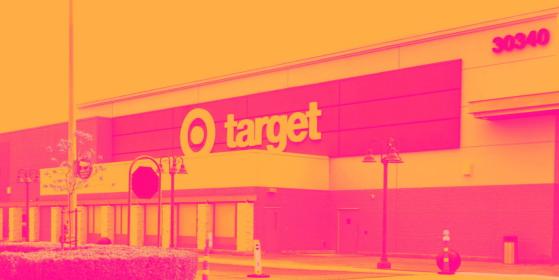General merchandise retailer Target (NYSE:TGT) reported results in line with analysts' expectations in Q3 FY2023, with revenue down 4.2% year on year to $25.4 billion. Turning to EPS, Target made a non-GAAP profit of $2.10 per share, improving from its profit of $1.54 per share in the same quarter last year.
Is now the time to buy Target? Find out by reading the original article on StockStory.
Target (TGT) Q3 FY2023 Highlights:
- Revenue: $25.4 billion vs analyst estimates of $25.24 billion (small beat)
- EPS (non-GAAP): $2.10 vs analyst estimates of $1.48 (41.8% beat)
- EPS (non-GAAP) Guidance for Q4 2023 is $2.25 at the midpoint, above analyst estimates of $2.24
- Free Cash Flow of $807 million is up from -$1.20 billion in the same quarter last year
- Gross Margin (GAAP): 28.5%, up from 25.8% in the same quarter last year
- Same-Store Sales were down 4.9% year on year (better than expectations of down 5.2% year on year)
- Store Locations: 1,956 at quarter end, increasing by 15 over the last 12 months
With a higher focus on style and aesthetics compared to other large general merchandise retailers, Target (NYSE:TGT) serves the suburban consumer who is looking for a wide range of products under one roof.
Large-format Grocery & General Merchandise RetailerBig-box retailers operate large stores that sell groceries and general merchandise at highly competitive prices. Because of their scale and resulting purchasing power, these big-box retailers–with annual sales in the tens to hundreds of billions of dollars–are able to get attractive volume discounts and sell at often the lowest prices. While e-commerce is a threat, these retailers have been able to weather the storm by either providing a unique in-store shopping experience or by reinvesting their hefty profits into omnichannel investments.
Sales GrowthTarget is a behemoth in the consumer retail sector and benefits from economies of scale, an important advantage giving the business an edge in distribution and more negotiating power with suppliers.
As you can see below, the company's annualized revenue growth rate of 8.3% over the last four years (we compare to 2019 to normalize for COVID-19 impacts) was decent despite not opening many new stores, implying that growth was driven by higher sales at existing, established stores.
This quarter, Target reported a rather uninspiring 4.2% year-on-year revenue decline, in line with Wall Street's expectations. Looking ahead, analysts expect sales to grow 1.4% over the next 12 months.
Number of StoresA retailer's store count is a crucial factor influencing how much it can sell, and store growth is a critical driver of how quickly its sales can grow.
When a retailer like Target keeps its store footprint steady, it usually means that demand is stable and it's focused on improving operational efficiency to increase profitability. As of the most recently reported quarter, Target operated 1,956 total retail locations, in line with its store count a year ago.
Taking a step back, the company has kept its physical footprint more or less flat over the last two years while other consumer retail businesses have opted for growth. A flat store base means that revenue growth must come from increased e-commerce sales or higher foot traffic and sales per customer at existing stores.
Same-Store Sales Target's demand within its existing stores has been relatively stable over the last eight quarters but fallen behind the broader consumer retail sector. On average, the company's same-store sales have grown by 1.2% year on year. Given its flat store count over the same period, this performance stems from increased foot traffic at existing stores or higher e-commerce sales as the company shifts demand from in-store to online.
In the latest quarter, Target's same-store sales fell 4.9% year on year. This decline was a reversal from the 2.7% year-on-year increase it posted 12 months ago. We'll be keeping a close eye on the company to see if this turns into a longer-term trend.
Key Takeaways from Target's Q3 Results With a market capitalization of $51.14 billion, a $1.91 billion cash balance, and positive free cash flow over the last 12 months, we're confident that Target has the resources needed to pursue a high-growth business strategy.
While same-store sales declined, it exceeded analysts' expectations. We were impressed by how significantly Target blew past analysts' EPS expectations this quarter, driven by a small beat on revenue, better profitability, and a lower-than-expected tax rate. The company also generated healthy operating cash flows and reduced its inventory. Next quarter's EPS guidance was slightly ahead of Consensus. Zooming out, we think this was an impressive quarter that should please shareholders, especially in light of some troubling consumer commentary from other companies. The stock is up 9.9% after reporting and currently trades at $121.7 per share.
The author has no position in any of the stocks mentioned in this report.
